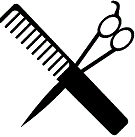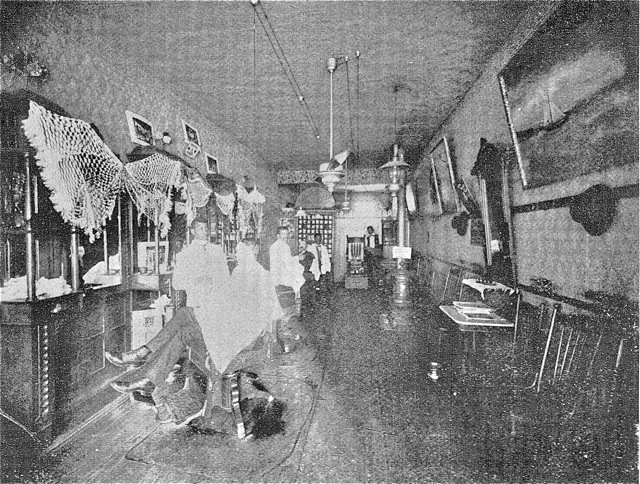Edward D. Gentry was
born in October 1865 in Kansas or Indian
Territory to Eli Gentry (1841–?) and
his wife Lucy (1842–?). His parents were
termed "mulatto" in Census records and
"colored" in Denison City Directories. Edward
had two younger siblings, William and Alyna or
Alyssa.
In Edward's teen
years, his father operated a saloon on South
Austin Avenue, organized a black minstrel
touring group, had frequent brushes with the
law, and participated in lodge activities in
the African American community. Living in a
busy downtown location at 205 West Woodard
Street, Edward's mother Lucy was a laundress
or stayed home raising the children. In
January 1880, the family mourned the death of
a small child.
In 1887, the
Denison City Directory listed Edward as a barber at Thompson &
Lott, operated by two African Americans, Joseph Thompson
and Sylvester Lott. This business, billed as
“barbers, shop and bath rooms,” occupied
space at
104 West Main Street (the Lebrecht
Building, built in 1884), at the southwest
corner of Main Street and Houston Avenue.
This was the heart of the action around
the Union Depot.
In 1891, Edward was a
barber with Eugene Lafon at 111 East Main
Street. He was rooming with another "colored"
barber, Jesse A. Coleman. Jesse's barber shop
shared a location at 209 South Austin Avenue
with Eli Gentry's nightclub; and Jesse lived
at 104 West Bond Street.
Also
in 1891, Edward married Susie, a black woman
born in October 1862 in Tennessee. In October
1892, they would have a daughter, Bernice.
Around this same time (1891), Eddie's parents
and his sister Alyna/Alyssa either moved away
or died, for they were no longer mentioned in
existing records. Nor do they appear in local
cemetery records.
Five
years later, Edward had his own barber shop at
109 East Main Street, close to the Union Depot
and in a prime location to catch travelers
tired after loading commodities onto trains or
emerging at their destination after long train
rides. Working the barber shop with Edward was
another African-American barber, James S.
Love.
Edward
continued to upgrade his enterprise, which was
located on the second floor above other
businesses and offered hot baths in addition
to shaves and haircuts. The 1898-1899 City
Directory called it the Palace Barber Shop,
and Eddie's former employer, Sylvester Lott,
worked there, as did Peter Williams and
Sherley O. Platt. They were all African
Americans. Williams may have been a part
owner, as the directory listed him also
operating another Palace Barber Shop at 106
North Rusk Avenue. At this time, Edward Gentry
and his wife had taken up residence at 627
West Bond Street. Platt lived a block away at
527 West Bond.
Through
1905, Edward remained at the same location and
lived at the same address. Then he moved his
business to 107 West Main in 1907. Around this
time, the interior of his shop was featured in
Industrial Denison, a
high-quality pictorial book advertising
Denison's most impressive homes and
businesses.
The Sunday
Gazetteer
Sunday, November 2, 1890
pg. 4
COLORED SOCIETY
Wednesday evening the colored Methodist
church, corner of Austin avenue and Bond
Street, was overflowing with the best and most
intelligent element of Denison's colored
population, the occasion being the marriage
ceremony of Ed Gentry and Susie Davis, Rev.
J.E. Russell, pastor of the congregation,
officiating. The building was
beautifully decorated. A number of white
people were present.
The wedding presents were as follows:
Mr. Gentry's father, sister and brothers
fitted the happy couple out with a complete
set of parlor, bedroom and kitchen furniture.
Mr. and Mrs. Joe Thompson, washstand set
Mr. and Mrs. D.W. Walton, silver napkin rings
Mrs. C. Diamond, china breakfast set and
silver spoons
Mr. and Mrs. McCracken and Mrs. and Miss Webb,
china dinner set
Nancy Van, a safe
Miss Cora Hudson and E. Hammonds, cut glass
water set
Mr. and Mrs. Ellisworth, cut glass water set
Mr. and Mrs. J. Coleman, cut glass set
Mr. and Mrs. Watson of Dallas, vinegar jar
Mr. and Mrs. Hale of Parsons, Kansas,
individual castors
Miss O. Smith, china desert set
Mr. and Mrs. M. Moss, silver spoons
Mr. and Mrs. D.W. Williams, silver spoons
Mr. and Mrs. N. Cubit, plus rocker
Mr. and Mrs. A. Stevenson, lamp and lace
curtains
Miss Reynolds, plush case, comb and brush
Mr. and Mrs. J.R. Reynolds, cuspidor
Mr. and Mrs. Maxey, culinary articles
Mr. and Mrs. Smallwood, table scarf
Miss Turner, napkins
Mr. and Mrs. W. Shaw, napkins
Miss Clark, napkins
Mr. and Mrs. James Poole, napkins
Mr. and Mrs. W.B. Johnson, napkins
Mr. and Mrs. Hill, table linen
Miss L. Hill, table linen
Mr. and Mrs. J. Smith, table linen
Scott Coleman, moustache cup
Madam Godin, carpet
Mr. and Mrs. Dr. Ray, butter knife
Miss Lizzie Reed, table hand-painted scarf
Miss . Gentry, hand-painted table scarf
Willie and Alice Gentry, center table
Plus sofa by S. Lott, Wash Poole, O. Scott, W.
Franklin, James Figures, C.H. Hamilton, and C.
Douglass, young men of Denison
Messrs Harvey and Herrin, bowl and pitcher
Miss A. WHite, cuspidor
Miss Jennie Duncans, pair vases
Mr. and Mrs. I. Crinshaw and Mr. and Mrs. Tom
Scott, fruit bowl and berry dishes
Miss Roxie Hill, cut glass water pitcher
Miss L. Pettit, vinegar jar
Mr. and Mrs. Russell, work basket and pitcher
Mr. and Mrs. I. Williams, hand-painted table
scarf
And many others which our space prevents
mentioning.
In October 1892, they
would have a daughter, Bernice. Around this
same time (1891), Eddie's parents and his
sister Alyna/Alyssa either moved away or died,
for they were no longer mentioned in existing
records. Nor do they appear in local cemetery
records.
Five years later,
Edward had his own barber shop at 109 East
Main Street, close to the Union Depot and in a
prime location to catch travelers tired after
loading commodities onto trains or emerging at
their destination after long train rides.
Working the barber shop with Edward was
another African-American barber, James S.
Love.
Edward continued to
upgrade his enterprise, which was located on
the second floor above other businesses and
offered hot baths in addition to shaves and
haircuts. The 1898-1899 City Directory called
it the Palace Barber Shop, and Eddie's former
employer, Sylvester Lott, worked there, as did
Peter Williams and Sherley O. Platt. They were
all African Americans. Williams may have been
a part owner, as the directory listed him also
operating another Palace Barber Shop at 106
North Rusk Avenue. At this time, Edward Gentry
and his wife had taken up residence at 627
West Bond Street. Platt lived a block away at
527 West Bond.
Through 1905, Edward
remained at the same location and lived at the
same address. Then he moved his business to
107 West Main in 1907. Around this time, the
interior of his shop was featured in Industrial Denison, a
high-quality pictorial book advertising
Denison's most impressive homes and
businesses.
"Shaving Parlor of E. D.
Gentry, 109 East Main Street."
Robinson, Frank M., comp. Industrial Denison.
[N.p.]: Means-Moore Co., [ca. 1909]. Page 54.



